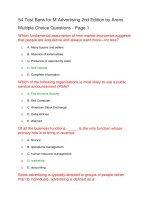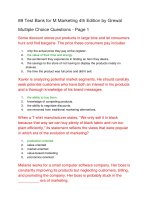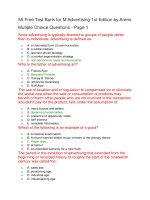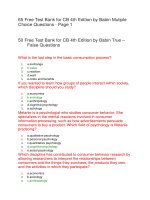Test bank for math and dosage calculations for healthcare professionals 4th edition by booth
Bạn đang xem bản rút gọn của tài liệu. Xem và tải ngay bản đầy đủ của tài liệu tại đây (112.29 KB, 31 trang )
Page 1 of 31
1
Student: _______________________________________________________________________________________
1. The numerator represents parts of the whole.
True False
2. The numerator is the bottom part of the fraction and represents the whole.
True False
3. The denominator represents part of the whole and is the bottom number of a fraction.
True False
4. Fractions measure a portion of a whole amount.
True False
5. Fractions cannot be used to show the relationship between part of a group and the whole group.
True False
6. If the numerator of a fraction is 1, the fraction equals the number in the denominator.
True False
7. A mixed number combines a whole number with a fraction.
True False
8. A mixed number is the combination of two fractions.
True False
9. Fractions with a value less than one are written as mixed numbers.
True False
10. To be equivalent fractions, two fractions must be written the same.
True False
11. Equivalent fractions have the same value even if written differently.
True False
12. The least common denominator is any number that is a common multiple of all denominators in
a group of fractions.
True False
Full file at />
Page 2 of 31
13. The smallest common multiple of all the denominators in a group of fractions is the least
common denominator.
True False
14. In order to compare fractions, they must be converted to equivalent fractions with common
denominators.
True False
15. 4/ > 3/
7
9
True False
16. 11/ < 22/
3
6
True False
17. 2/ > 1/
18
5
True False
18. 1¾ < 14/
5
True False
19. 7/ > x/ < ¾
8
40
True False
20. When reduced to its lowest term, 35/ = 1¾
20
True False
21. 39/ is written in its simplest form.
51
True False
5
22. 210/
160 reduced to its lowest terms = 1 /16
True False
23. Mixed fractions help to add and subtract fractions with different denominators.
True False
24. When adding fractions or subtracting fractions, the LCD will be the denominator of the answer.
True False
Full file at />
Page 3 of 31
25. Prior to adding or subtracting fractions, it is not necessary to convert mixed numbers to
fractions.
True False
26. A common denominator is necessary to multiply or divide fractions.
True False
27. Mixed or whole numbers must be converted to fractions when multiplying or dividing fractions.
True False
28. To divide fractions, the divisor is inverted and the dividend is multiplied by this reciprocal of the
divisor.
True False
29. 5/ is less than 3/
6
10
True False
30. The fractions1/ , ¾, 4/ are in the correct order of value from lowest to highest.
3
5
True False
31. A(n) ____________ fraction represents equal parts of a whole.
A.
B.
C.
D.
equivalent
mixed
common
improper
32. The smallest number that is a common multiple of all the denominators in a group of fractions is
the
A.
B.
C.
D.
numerator.
least common denominator.
equivalent fraction.
prime number.
33. A(n) ___________________ is a number other than one that can be evenly divided only by
itself.
A.
B.
C.
D.
numerator
mixed number
equivalent fraction
prime number
34. The top number on a fraction, which represents parts of the whole, is the
A. numerator.
B. least common denominator.
Full file at />
Page 4 of 31
C. equivalent fractions.
D. denominator.
35. __________________ are two fractions that are written differently and have the same value.
A.
B.
C.
D.
Mixed numbers
Least common denominators
Equivalent fractions
Prime numbers
36. The bottom number of a fraction, which represents the whole, is the
A.
B.
C.
D.
numerator.
least common denominator.
equivalent fractions.
denominator.
37. A(n) ___________________ combines a whole number with a fraction.
A.
B.
C.
D.
numerator
least common denominator
equivalent fraction
mixed number
38. To reduce a number to its simplest form, find the largest _____________ that divides evenly into
both the numerator and denominator.
A.
B.
C.
D.
mixed number
whole number
prime number
proper fraction
39. 4/ + 15/ = _____ (reduce to lowest terms)
5
6
A. 23/
6
B. 24/
5
C. 219
/30
D. 29/
11
40. ¾ + 6/ + 2 2/ = _________ (reduce to lowest terms)
8
8
A. 3 ¾
B. 3 6/
8
C. 2 11/
12
D. 2 5/
6
41. 5 6/ - 2 2/ = __________ (reduce to lowest terms)
8
3
A.
Full file at />
Page 5 of 31
38/11
B. 3 4/
5
C. 3 1/
12
D. 3 1/
6
42. 15 ¾ - 5 = ________ (reduce to lowest terms)
A.
B.
C.
D.
10 ¼
9¼
10 ¾
9¾
43. 3/ x 2/ = _______ (reduce to lowest terms)
5
8
A. 3/
20
5
B. /
6
C. 1
D. 1/
8
44. 1 ½ x 2/ = ________ (reduce to lowest terms)
3
A. 1 2/
6
B. 2
C. 1
D. 1 3/
5
2
45. 4/
5
/3 = __________ (reduce to lowest terms)
A. 8/
15
B. 6/
8
C. 1 1/
5
D. 1 ¾
46. 4 3/
8
1 1/2 = _________ (reduce to lowest terms)
A. 3
B. 2 4/
10
C. 2 1/
6
D. 2 11/
12
47. The least common denominator for 6/ , 5/ , ¾, and ½ is
10 8
A. 12
B. 40
Full file at />
Page 6 of 31
C. 32
D. 80
48. What is the least common denominator for 5/ , 5/ , and 3/ ?
6 3
4
A.
B.
C.
D.
24
48
20
12
49. The missing numerator for 5/ = x/ is
6
12
A.
B.
C.
D.
8
6
10
11
50. The sum of 2 1/ + 3/ + 4/ written in the proper form and reduced to lowest terms is?
3
10
9
A. 277/
90
B. 3 7/
90
C. 3 7/
9
D. 9 3/
7
51. 9/ x 1 ¾ = (in proper form and reduced to lowest terms) ______________.
10
A. 108/
40
B. 2 28/
40
23
C. 1 /
40
D.
17
/14
52. 2 2/ – 4/ = ___________ (in proper form and reduced to lowest terms).
6
6
A. 1 2/
3
B. 1 4/
6
C. 2
D. 1 2/
6
53. 1/ – ¼ = __________ (in proper form and reduced to lowest terms).
3
A.
B.
C.
0
½
2
/12
D. 1/
12
Full file at />
Page 7 of 31
54. 8/
9
1/
4=
___________ (in proper form and reduced to lowest terms)
A. 3 2/
9
B. 2 3/
9
C. 3 5/
9
D. 2/
9
55. Find the missing numerator in 7/ = x/ ? = ______________
8
32
________________________________________
56. Find the missing numerator in 6 2/ = x/ ? = __________
3
18
________________________________________
57. The least common denominator of 1 2/ and 2 ¾ is ___________.
3
________________________________________
58. The least common denominator of 4/ and 6/ is ___________.
7
8
________________________________________
59. Insert >, <, or = to make a true statement: 2 4/ ___ 2 3/ .
5
6
________________________________________
60. 13 8/ - 10 8/ = _____________.
17
17
________________________________________
61. The patient's chart indicates that he weighed 175 pounds at the end of September. He then gained
2 ½ pounds in October and lost ¾ pound in November. He weighed ___________ pounds at the
end of November.
________________________________________
62. A health care professional opens a case that has a total of 100 ounces of medicine. If each vial in
the case holds 1 ¼ ounces, how many vials are in the case?
________________________________________
63. 4/ = x/ ; ? = ____________
5
25
________________________________________
64. Insert >, <, or = to make a true statement: 4/ ___ 4/ .
5
9
Full file at />
Page 8 of 31
________________________________________
65. Insert >, <, or = to make a true statement: 4/ ___ 1 1/ .
3
3
________________________________________
66. Insert >, <, or = to make a true statement: 6/ ___ 8/ .
24
12
________________________________________
67. 6 6/ - 4 13/ =____________ .Write the answer as a mixed number reduced to lowest terms.
7
14
68. Convert 95/ to a mixed number: ______________ (reduce to lowest terms)
25
69. Convert 57/ to a mixed number: _____________ (reduce to lowest terms)
13
70. Convert 24 3/ into a fraction: _____________
8
71. Convert 73/ into a mixed number: ___________ (reduce to lowest terms)
8
72. The sum of 4 + 11/ = ______________ . Write the answer as a mixed number reduced to
13
lowest terms.
Full file at />
Page 9 of 31
73. The sum of 2/ + 8/ = ___________ . Write the answer as a mixed number reduced to lowest
3
9
terms.
74. The sum of 4/ + 11/ = __________ . Write the answer as a mixed number reduced to lowest
5
15
terms.
75. 15/ - 6/ = ____________.
22
22
76. 5/ x ¾ = __________
8
77. 2/ x 1/ x ½ = ______________ . Reduce the answer to the lowest terms.
3
3
78. 2 1/ x 3 2/ = __________ . Write the answer in the lowest terms.
6
3
Full file at />
Page 10 of 31
79. ¾
80. 2/
9
81. 4 2/
5
5
/8 = _________. Write the answer as a mixed fraction in the lowest terms.
2/
8=
_________ . Reduce the answer to the lowest terms.
1 3/8 = ___________. Reduce the answer to the lowest terms.
82. The lowest three equivalent fractions 5/ are ________, _______, and ________
12
83. 18/ simplified to its lowest terms is ___________.
37
84. ¾ - 1/ = ____________.
3
85. 1 1/ – 2/ = ____________.
8
5
Full file at />
Page 11 of 31
86. 1 1/ + 2/ = ____________ (in proper form and reduced to lowest terms).
8
5
87. 1 1/ x 2/ = ___________ (in proper form and reduced to lowest terms).
8
5
88. 1 1/
8
2/
5=
__________.
89. 1 ½ + 6 3/ + ¾ = ____________.
8
Full file at />
Page 12 of 31
1 KEY
1. (p. 3) The numerator represents parts of the whole.
TRUE
The numerator represents parts of the whole.
Blooms: Remembering
Booth - Chapter 001 #1
Difficulty: Easy
Learning Outcome: 1.1 Produce fractions and mixed numbers in the proper form.
2. (p. 3) The numerator is the bottom part of the fraction and represents the whole.
FALSE
The denominator is the bottom part of a fraction and represents the whole.
Blooms: Remembering
Booth - Chapter 001 #2
Difficulty: Easy
Learning Outcome: 1.1 Produce fractions and mixed numbers in the proper form.
3. (p. 3) The denominator represents part of the whole and is the bottom number of a fraction.
FALSE
The denominator represents the whole and is the bottom number of a fraction.
Blooms: Remembering
Booth - Chapter 001 #3
Difficulty: Easy
Learning Outcome: 1.1 Produce fractions and mixed numbers in the proper form.
4. (p. 3) Fractions measure a portion of a whole amount.
TRUE
Fractions measure a portion of a whole amount.
Blooms: Remembering
Booth - Chapter 001 #4
Difficulty: Easy
Learning Outcome: 1.1 Produce fractions and mixed numbers in the proper form.
Learning Outcome: 1.5 Compare the values of fractions.
5. (p. 3) Fractions cannot be used to show the relationship between part of a group and the whole
group.
FALSE
Fractions can be used to show the relationship between part of a group and the whole group.
Blooms: Remembering
Booth - Chapter 001 #5
Difficulty: Easy
Learning Outcome: 1.1 Produce fractions and mixed numbers in the proper form.
Learning Outcome: 1.5 Compare the values of fractions.
6. (p. 16) If the numerator of a fraction is 1, the fraction equals the number in the denominator.
FALSE
Full file at />
Page 13 of 31
If the denominator of a fraction is 1, the fraction equals the number in the numerator.
Blooms: Remembering
Booth - Chapter 001 #6
Difficulty: Easy
Learning Outcome: 1.5 Compare the values of fractions.
7. (p. 4) A mixed number combines a whole number with a fraction.
TRUE
A mixed number combines a whole number with a fraction.
Blooms: Remembering
Booth - Chapter 001 #7
Difficulty: Easy
Learning Outcome: 1.1 Produce fractions and mixed numbers in the proper form.
8. (p. 4) A mixed number is the combination of two fractions.
FALSE
A mixed number combines a whole number with a fraction.
Blooms: Remembering
Booth - Chapter 001 #8
Difficulty: Easy
Learning Outcome: 1.1 Produce fractions and mixed numbers in the proper form.
9. (p. 4) Fractions with a value less than one are written as mixed numbers.
FALSE
Fractions with a value greater than one are written as mixed numbers.
Blooms: Remembering
Booth - Chapter 001 #9
Difficulty: Easy
Learning Outcome: 1.1 Produce fractions and mixed numbers in the proper form.
10. (p. 8) To be equivalent fractions, two fractions must be written the same.
FALSE
To be equivalent fractions, two fractions must have the same value even if written differently.
Blooms: Remembering
Booth - Chapter 001 #10
Difficulty: Easy
Learning Outcome: 1.2 Produce and identify equivalent fractions.
11. (p. 8) Equivalent fractions have the same value even if written differently.
TRUE
Equivalent fractions have the same value even if written differently.
Blooms: Remembering
Booth - Chapter 001 #11
Difficulty: Easy
Learning Outcome: 1.2 Produce and identify equivalent fractions.
12. (p. 13) The least common denominator is any number that is a common multiple of all
denominators in a group of fractions.
Full file at />
Page 14 of 31
FALSE
The least common denominator is the smallest common multiple of all the denominators in a group
of fractions.
Blooms: Remembering
Booth - Chapter 001 #12
Difficulty: Medium
Learning Outcome: 1.4 Find the least common denominator.
13. (p. 13) The smallest common multiple of all the denominators in a group of fractions is the least
common denominator.
TRUE
The smallest common multiple of all the denominators in a group of fractions is the least common
denominator.
Blooms: Remembering
Booth - Chapter 001 #13
Difficulty: Medium
Learning Outcome: 1.4 Find the least common denominator.
14. (p. 13) In order to compare fractions, they must be converted to equivalent fractions with common
denominators.
TRUE
In order to compare fractions, they must be converted to equivalent fractions with common
denominators.
Blooms: Remembering
Booth - Chapter 001 #14
Difficulty: Medium
Learning Outcome: 1.4 Find the least common denominator.
15. (p. 14) 4/ > 3/
7
9
TRUE
4/
7
x 9/9 = 36/63 and 3/9 x 7/7 = 21/63 36/63 > 21/36 therefore 4/7 >3/9
Blooms: Understanding
Booth - Chapter 001 #15
Difficulty: Medium
Learning Outcome: 1.4 Find the least common denominator.
Learning Outcome: 1.5 Compare the values of fractions.
16. (p. 14) 11/ < 22/
3
6
FALSE
11/
3
= x/12 = 44/12 and 22/6 = x/12 = 44/12 44/12 = 44/12, therefore 11/3 is not < 22/6
Blooms: Understanding
Booth - Chapter 001 #16
Difficulty: Medium
Learning Outcome: 1.4 Find the least common denominator.
Learning Outcome: 1.5 Compare the values of fractions.
17. (p. 14)
Full file at />
Page 15 of 31
2/
18 >
1/
5
FALSE
2/
18 x
5/
5=
10/
90 and
1/
5
x 18/18 = 18/90 10/90 is not > 18/90, therefore 2/18 is not > 1/5
Blooms: Understanding
Booth - Chapter 001 #17
Difficulty: Medium
Learning Outcome: 1.4 Find the least common denominator.
Learning Outcome: 1.5 Compare the values of fractions.
18. (p. 17) 1¾ < 14/
5
TRUE
1¾ = 7/4 = 35/20 and 14/5 = 9/5 = 36/20 35/20 is < 36/20
Blooms: Understanding
Booth - Chapter 001 #18
Difficulty: Medium
Learning Outcome: 1.4 Find the least common denominator.
Learning Outcome: 1.5 Compare the values of fractions.
19. (p. 17) 7/ > x/ < ¾
8
40
TRUE
7/
8
= x/40 = 28/40 7/8 = 35/40 = 28/40 and 7/10 = 28/40 35/40 is > than 28/40 which is < 30/40
Blooms: Understanding
Booth - Chapter 001 #19
Difficulty: Medium
Learning Outcome: 1.4 Find the least common denominator.
Learning Outcome: 1.5 Compare the values of fractions.
20. (p. 17) When reduced to its lowest term, 35/ = 1¾
20
TRUE
35/
20
= 115/20 = 1¾
Blooms: Understanding
Booth - Chapter 001 #20
Difficulty: Medium
Learning Outcome: 1.1 Produce fractions and mixed numbers in the proper form.
Learning Outcome: 1.3 Determine the simplest form of a fraction.
21. (p. 11) 39/ is written in its simplest form.
51
FALSE
39 and 51 are both divisible by 3, therefore, 39/51 = 13/17 in its simplest form.
Blooms: Understanding
Booth - Chapter 001 #21
Difficulty: Medium
Learning Outcome: 1.3 Determine the simplest form of a fraction.
Full file at />
Page 16 of 31
22. (p. 11) 210/ reduced to its lowest terms = 15/
160
16
TRUE
210/
160 reduced
to its lowest terms = 15/16
Blooms: Understanding
Booth - Chapter 001 #22
Difficulty: Medium
Learning Outcome: 1.1 Produce fractions and mixed numbers in the proper form.
Learning Outcome: 1.3 Determine the simplest form of a fraction.
23. (p. 19) Mixed fractions help to add and subtract fractions with different denominators.
FALSE
Equivalent fractions help to add and subtract fractions with different denominators.
Blooms: Understanding
Booth - Chapter 001 #23
Difficulty: Medium
Learning Outcome: 1.2 Produce and identify equivalent fractions.
Learning Outcome: 1.6 Add fractions.
Learning Outcome: 1.7 Subtract fractions.
24. (p. 19) When adding fractions or subtracting fractions, the LCD will be the denominator of the
answer.
TRUE
When adding fractions, the LCD will be the denominator of the answer.
Blooms: Remembering
Booth - Chapter 001 #24
Difficulty: Easy
Learning Outcome: 1.4 Find the least common denominator.
Learning Outcome: 1.6 Add fractions.
Learning Outcome: 1.7 Subtract fractions.
25. (p. 19) Prior to adding or subtracting fractions, it is not necessary to convert mixed numbers to
fractions.
FALSE
Prior to adding or subtracting fractions, mixed numbers should be converted to fractions.
Blooms: Remembering
Booth - Chapter 001 #25
Difficulty: Easy
Learning Outcome: 1.1 Produce fractions and mixed numbers in the proper form.
Learning Outcome: 1.6 Add fractions.
Learning Outcome: 1.7 Subtract fractions.
26. (p. 23) A common denominator is necessary to multiply or divide fractions.
FALSE
It is not necessary to find a common denominator to multiply or divide fractions.
Blooms: Remembering
Booth - Chapter 001 #26
Difficulty: Easy
Learning Outcome: 1.8 Multiply fractions.
Full file at />
Page 17 of 31
Learning Outcome: 1.9 Divide fractions.
27. (p. 24) Mixed or whole numbers must be converted to fractions when multiplying or dividing
fractions.
TRUE
Mixed or whole numbers must be converted to fractions when multiplying or dividing fractions.
Blooms: Remembering
Booth - Chapter 001 #27
Difficulty: Easy
Learning Outcome: 1.1 Produce fractions and mixed numbers in the proper form.
Learning Outcome: 1.8 Multiply fractions.
Learning Outcome: 1.9 Divide fractions.
28. (p. 28) To divide fractions, the divisor is inverted and the dividend is multiplied by this reciprocal
of the divisor.
TRUE
To divide fractions, the divisor is inverted and the dividend is multiplied by this reciprocal of the
divisor.
Blooms: Remembering
Booth - Chapter 001 #28
Difficulty: Easy
Learning Outcome: 1.9 Divide fractions.
29. (p. 16) 5/ is less than 3/
6
10
FALSE
5/
6
= 50/60 = 25/30 and 3/10 = 18/60 = 9/30; 25/30 is greater than 9/30, therefore 5/6 is greater than 3/10
Blooms: Applying
Booth - Chapter 001 #29
Difficulty: Medium
Learning Outcome: 1.2 Produce and identify equivalent fractions.
Learning Outcome: 1.4 Find the least common denominator.
Learning Outcome: 1.5 Compare the values of fractions.
30. (p. 16) The fractions1/ , ¾, 4/ are in the correct order of value from lowest to highest.
3
5
TRUE
1/
3
= 20/60; ¾ = 45/60; 4/5 = 48/60 20/60 < 45/60 < 48/60
Blooms: Applying
Booth - Chapter 001 #30
Difficulty: Medium
Learning Outcome: 1.2 Produce and identify equivalent fractions.
Learning Outcome: 1.4 Find the least common denominator.
Learning Outcome: 1.5 Compare the values of fractions.
31. (p. 3) A(n) ____________ fraction represents equal parts of a whole.
A.
B.
C.
D.
equivalent
mixed
common
improper
Full file at />
Page 18 of 31
A common fraction represents equal parts of a whole.
Blooms: Remembering
Booth - Chapter 001 #31
Difficulty: Easy
Learning Outcome: 1.1 Produce fractions and mixed numbers in the proper form.
32. (p. 13) The smallest number that is a common multiple of all the denominators in a group of
fractions is the
A.
B.
C.
D.
numerator.
least common denominator.
equivalent fraction.
prime number.
The smallest number that is a common multiple of all the denominators in a group of fractions is the
least common denominator.
Blooms: Remembering
Booth - Chapter 001 #32
Difficulty: Easy
Learning Outcome: 1.4 Find the least common denominator.
33. (p. 12) A(n) ___________________ is a number other than one that can be evenly divided only by
itself.
A.
B.
C.
D.
numerator
mixed number
equivalent fraction
prime number
A prime number is a number other than one that can be evenly divided only by themselves.
Blooms: Remembering
Booth - Chapter 001 #33
Difficulty: Easy
Learning Outcome: 1.3 Determine the simplest form of a fraction.
34. (p. 3) The top number on a fraction, which represents parts of the whole, is the
A.
B.
C.
D.
numerator.
least common denominator.
equivalent fractions.
denominator.
The top number on a fraction; represents parts of the whole is the numerator.
Blooms: Remembering
Booth - Chapter 001 #34
Difficulty: Easy
Learning Outcome: 1.1 Produce fractions and mixed numbers in the proper form.
35. (p. 8) __________________ are two fractions that are written differently and have the same value.
A.
B.
C.
D.
Mixed numbers
Least common denominators
Equivalent fractions
Prime numbers
Equivalent fractions are two fractions that are written differently and have the same value.
Full file at />
Page 19 of 31
Blooms: Remembering
Booth - Chapter 001 #35
Difficulty: Easy
Learning Outcome: 1.2 Produce and identify equivalent fractions.
36. (p. 3) The bottom number of a fraction, which represents the whole, is the
A.
B.
C.
D.
numerator.
least common denominator.
equivalent fractions.
denominator.
The bottom number of a fraction; that represents the whole is the denominator.
Blooms: Remembering
Booth - Chapter 001 #36
Difficulty: Easy
Learning Outcome: 1.1 Produce fractions and mixed numbers in the proper form.
37. (p. 4) A(n) ___________________ combines a whole number with a fraction.
A.
B.
C.
D.
numerator
least common denominator
equivalent fraction
mixed number
A mixed number combines a whole number with a fraction.
Blooms: Remembering
Booth - Chapter 001 #37
Difficulty: Easy
Learning Outcome: 1.1 Produce fractions and mixed numbers in the proper form.
38. (p. 11) To reduce a number to its simplest form, find the largest _____________ that divides
evenly into both the numerator and denominator.
A.
B.
C.
D.
mixed number
whole number
prime number
proper fraction
To reduce a number to its simplest form, find the largest whole number that divides evenly into both
the numerator and denominator.
Blooms: Remembering
Booth - Chapter 001 #38
Difficulty: Easy
Learning Outcome: 1.3 Determine the simplest form of a fraction.
39. (p. 19) 4/ + 15/ = _____ (reduce to lowest terms)
5
6
A. 23/
6
B. 24/
5
C. 219
/30
D.
29/
4/
= 24/30 15/6 = 11/6 = 55/30 24/30 + 55/30 = 79/30 = 219/30
5
11
Full file at />
Page 20 of 31
Blooms: Applying
Booth - Chapter 001 #39
Difficulty: Medium
Learning Outcome: 1.3 Determine the simplest form of a fraction.
Learning Outcome: 1.6 Add fractions.
40. (p. 19) ¾ + 6/ + 2 2/ = _________ (reduce to lowest terms)
8
8
A. 3 ¾
B. 3 6/
8
C. 2 11/
12
D. 2 5/
6
¾ = 6/8 and 6/8 = 6/8 2 2/8 = 18/8 6/8 + 6/8 + 18/8 = 30/8 = 3 6/8 = 3 ¾
Blooms: Applying
Booth - Chapter 001 #40
Difficulty: Medium
Learning Outcome: 1.3 Determine the simplest form of a fraction.
Learning Outcome: 1.6 Add fractions.
41. (p. 21) 5 6/ - 2 2/ = __________ (reduce to lowest terms)
8
3
A. 38/
11
B. 3 4/
5
C. 3 1/
12
D. 3 1/
6
5 6/8 = 46/8 = 138/24 2 2/3 = 8/3 = 64/24 138/24 - 64/24 = 3 2/24 = 3 1/12
Blooms: Applying
Booth - Chapter 001 #41
Difficulty: Medium
Learning Outcome: 1.3 Determine the simplest form of a fraction.
Learning Outcome: 1.7 Subtract fractions.
42. (p. 21) 15 ¾ - 5 = ________ (reduce to lowest terms)
A.
B.
C.
D.
10 ẳ
9ẳ
10 ắ
9ắ
15 ¾ = 63/4 5 = 5/1 =20/4 63/4 - 20/4 = 43/4 = 10 ¾
Blooms: Applying
Booth - Chapter 001 #42
Difficulty: Medium
Learning Outcome: 1.3 Determine the simplest form of a fraction.
Learning Outcome: 1.7 Subtract fractions.
43. (p. 24) 3/ x 2/ = _______ (reduce to lowest terms)
5
8
A. 3/
20
B.
Full file at />
Page 21 of 31
5/
6
C. 1
D. 1/
8
3/
5
x 2/8 = 6/40 = 3/20
Blooms: Applying
Booth - Chapter 001 #43
Difficulty: Medium
Learning Outcome: 1.3 Determine the simplest form of a fraction.
Learning Outcome: 1.8 Multiply fractions.
44. (p. 24) 1 ½ x 2/ = ________ (reduce to lowest terms)
3
A. 1 2/
6
B. 2
C. 1
D. 1 3/
5
1 ½ = 3/2 x 2/3 = 6/6 = 1
Blooms: Applying
Booth - Chapter 001 #44
Difficulty: Medium
Learning Outcome: 1.3 Determine the simplest form of a fraction.
Learning Outcome: 1.8 Multiply fractions.
45. (p. 28) 4/
5
2/
3
= __________ (reduce to lowest terms)
A. 8/
15
B. 6/
8
C. 1 1/
5
D. 1 ¾
4/
5
2/
3
= 4/5 x 3/2 = 12/10 = 1 2/10 = 1 1/5
Blooms: Applying
Booth - Chapter 001 #45
Difficulty: Medium
Learning Outcome: 1.3 Determine the simplest form of a fraction.
Learning Outcome: 1.9 Divide fractions.
46. (p. 28) 4 3/
8
1 1/2 = _________ (reduce to lowest terms)
A. 3
B. 2 4/
10
1
C. 2 /
6
11
D. 2 /
12
4 3/8 = 35/8; 1 1/2 = 3/2 35/8
3/
2
= 35/8 X2/3 = 70/24 = 2 22/24 = 2 11/12
Blooms: Applying
Full file at />
Page 22 of 31
Booth - Chapter 001 #46
Difficulty: Medium
Learning Outcome: 1.3 Determine the simplest form of a fraction.
Learning Outcome: 1.9 Divide fractions.
47. (p. 14) The least common denominator for 6/ , 5/ , ắ, and ẵ is
10 8
A.
B.
C.
D.
12
40
32
80
40 is the smallest number all the denominators will divide into equally.
Blooms: Applying
Booth - Chapter 001 #47
Difficulty: Medium
Learning Outcome: 1.4 Find the least common denominator.
48. (p. 14) What is the least common denominator for 5/ , 5/ , and 3/ ?
6 3
4
A.
B.
C.
D.
24
48
20
12
12 is the smallest number all the denominators will divide into equally.
Blooms: Applying
Booth - Chapter 001 #48
Difficulty: Easy
Learning Outcome: 1.4 Find the least common denominator.
49. (p. 10) The missing numerator for 5/ = x/ is
6
12
A.
B.
C.
D.
8
6
10
11
Multiply the original numerator by the denominator of the new fraction and divide the product by the
original denominator. 5 x 12 = 60; 60 6 = 10
Blooms: Applying
Booth - Chapter 001 #49
Difficulty: Easy
Learning Outcome: 1.2 Produce and identify equivalent fractions.
50. (p. 19) The sum of 2 1/ + 3/ + 4/ written in the proper form and reduced to lowest terms is?
3
10
9
A. 277/
90
B. 3 7/
90
C. 3 7/
9
3
D. 9 /
7
LCD = 90 so 2 1/3 + 3/10 + 4/9 = 210/90 + 27/90 + 40/90 = . 277/90 which equals 3 7/90 in proper form.
Full file at />
Page 23 of 31
Blooms: Applying
Booth - Chapter 001 #50
Difficulty: Hard
Learning Outcome: 1.1 Produce fractions and mixed numbers in the proper form.
Learning Outcome: 1.2 Produce and identify equivalent fractions.
Learning Outcome: 1.6 Add fractions.
51. (p. 24) 9/ x 1 ¾ = (in proper form and reduced to lowest terms) ______________.
10
A. 108/
40
B. 2 28/
40
C. 1 23/
40
D. 17/
14
9/
10 x
1 ¾ = 9/10 x 7/4 = 63/40 = 1 23/40
Blooms: Applying
Booth - Chapter 001 #51
Difficulty: Medium
Learning Outcome: 1.2 Produce and identify equivalent fractions.
Learning Outcome: 1.3 Determine the simplest form of a fraction.
Learning Outcome: 1.8 Multiply fractions.
52. (p. 21) 2 2/ – 4/ = ___________ (in proper form and reduced to lowest terms).
6
6
A. 1 2/
3
B. 1 4/
6
C. 2
D. 1 2/
6
2 2/6 – 4/6 = 14/6 – 4/6 = 10/6 = 1 4/6 = 1 2/3
Blooms: Applying
Booth - Chapter 001 #52
Difficulty: Easy
Learning Outcome: 1.1 Produce fractions and mixed numbers in the proper form.
Learning Outcome: 1.7 Subtract fractions.
53. (p. 21) 1/ – ¼ = __________ (in proper form and reduced to lowest terms).
3
A.
B.
C.
0
ẵ
2/
12
D. 1/
12
1/
3
ẳ = 4/12 3/12 = 1/12
Blooms: Applying
Booth - Chapter 001 #53
Difficulty: Easy
Learning Outcome: 1.4 Find the least common denominator.
Learning Outcome: 1.7 Subtract fractions.
54. (p. 28) 8/
9
1/
4
= ___________ (in proper form and reduced to lowest terms)
Full file at />
Page 24 of 31
A. 3 2/
9
3
B. 2 /
9
C. 3 5/
9
D. 2/
9
8/
9
1/
4
= 8/9 x 4/1 = 32/9 = 3 5/9
Blooms: Applying
Booth - Chapter 001 #54
Difficulty: Easy
Learning Outcome: 1.1 Produce fractions and mixed numbers in the proper form.
Learning Outcome: 1.3 Determine the simplest form of a fraction.
Learning Outcome: 1.9 Divide fractions.
55. (p. 10) Find the missing numerator in 7/ = x/ ? = ______________
8
32
28
Multiply the original numerator by the denominator of the new fraction and divide the product by the
original denominator 7 x 32 = 244 8 = 28
Blooms: Applying
Booth - Chapter 001 #55
Difficulty: Medium
Learning Outcome: 1.2 Produce and identify equivalent fractions.
56. (p. 10) Find the missing numerator in 6 2/ = x/ ? = __________
3
18
120
Convert mixed fraction: 6 2/3 = 20/3. Multiply the original numerator by the denominator of the new
fraction and divide the product by the original denominator 20x18 = 360 3 = 120
Blooms: Applying
Booth - Chapter 001 #56
Difficulty: Medium
Learning Outcome: 1.2 Produce and identify equivalent fractions.
57. (p. 14) The least common denominator of 1 2/ and 2 ¾ is ___________.
3
12
12 is the smallest multiple of both 3 and 4.
Blooms: Applying
Booth - Chapter 001 #57
Difficulty: Medium
Learning Outcome: 1.4 Find the least common denominator.
58. (p. 14) The least common denominator of 4/ and 6/ is ___________.
7
8
56
56 is the smallest multiple of both 7 and 8.
Blooms: Applying
Booth - Chapter 001 #58
Full file at />
Page 25 of 31
Difficulty: Medium
Learning Outcome: 1.4 Find the least common denominator.
59. (p. 17) Insert >, <, or = to make a true statement: 2 4/ ___ 2 3/ .
5
6
Blooms: Applying
Booth - Chapter 001 #59
Difficulty: Medium
Learning Outcome: 1.5 Compare the values of fractions.
60. (p. 21) 13 8/ - 10 8/ = _____________.
17
17
3
13 8/17 = 229/17 10 8/17 = 178/11 229/17 - 178/17 = 51/17 = 3
Blooms: Applying
Booth - Chapter 001 #60
Difficulty: Easy
Learning Outcome: 1.1 Produce fractions and mixed numbers in the proper form.
Learning Outcome: 1.2 Produce and identify equivalent fractions.
Learning Outcome: 1.3 Determine the simplest form of a fraction.
Learning Outcome: 1.7 Subtract fractions.
61. (p. 19) The patient's chart indicates that he weighed 175 pounds at the end of September. He then
gained 2 ẵ pounds in October and lost ắ pound in November. He weighed ___________
pounds at the end of November.
Blooms: Understanding
Booth - Chapter 001 #61
Difficulty: Hard
Learning Outcome: 1.1 Produce fractions and mixed numbers in the proper form.
Learning Outcome: 1.2 Produce and identify equivalent fractions.
Learning Outcome: 1.3 Determine the simplest form of a fraction.
Learning Outcome: 1.6 Add fractions.
Learning Outcome: 1.7 Subtract fractions.
62. (p. 28) A health care professional opens a case that has a total of 100 ounces of medicine. If each
vial in the case holds 1 ¼ ounces, how many vials are in the case?
80
100 = 100/1; 1 ¼ = 5/4 100/1
5/
4=
100/
4
400/ =
1 x /5 =
5
80
Blooms: Understanding
Booth - Chapter 001 #62
Difficulty: Hard
Learning Outcome: 1.1 Produce fractions and mixed numbers in the proper form.
Learning Outcome: 1.9 Divide fractions.
63. (p. 10) 4/ = x/ ; ? = ____________
5
25
20
To find the missing numerator when the denominator of the equivalent fraction is larger than the
original denominator, divide the larger denominator by the smaller one and multiply the original
numerator by the quotient. 25 5 = 5 x 4 = 20.
Full file at />









